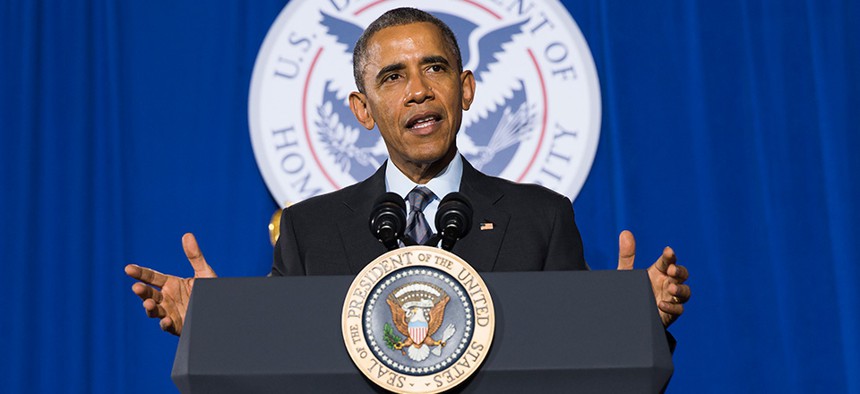
Evan Vucci/AP
Obama’s Budget Message to Feds: ‘I Have Your Back’
White House unveils its plan for ‘strengthening the federal workforce.’
President Obama called for a total overhaul of the federal civil service system in his fiscal 2016 budget proposal, deriding the current structure as an antiquated relic of generations past.
In a section of his budget blueprint labeled as his plan for “strengthening the federal workforce,” Obama said federal employees have endured significant restrictions during his administration and deserve better. Unleashing the federal workforce from spending caps and compensation cuts will empower the government to better serve the American people, the White House said.
In a speech Monday unveiling his budget -- delivered to a group of Homeland Security Department employees, but with a message apparently aimed at the entire federal workforce -- Obama promised to fight for his civil servants.
“We ask a lot of you,” Obama said. “The least we can do is have your backs. That’s what I’m going to keep on doing for as long as I have the honor of serving as your president. I have your back. And I’m going to keep on fighting to make sure that you get the resources you deserve.”
To demonstrate that support, Obama called on Congress to pass a full-year funding measure for DHS immediately, saying the agency’s employees have families to support and cannot afford to go any amount of time without a paycheck. In his budget, Obama said rhetoric disparaging federal employees hurts the functioning of government.
“A national climate of criticism of service in the federal bureaucracy makes it difficult to recruit the needed workforce and convince them to commit their talents and develop into future leaders,” the White House wrote.
After all, the White House said, federal employees are regular Americans who have continued to deliver despite trying circumstances.
“Federal employees are our neighbors, civic leaders and taxpayers, too,” the White House wrote. “Every day, federal employees actively collaborate with the private and nonprofit sectors to advance our national priorities. During five years of delayed budgets, sequestration, pay freezes and award caps, federal employees have come in every day to serve their country.”
Fully delivering for federal employees will require more than just kinder words, Obama conceded in his budget. The General Schedule classification system is antiquated, the White House said, and hiring, firing, promotion and compensation policies no longer serve the needs of a modern workforce.
“Quite simply, a 21st century government cannot continue to operate using 20th century processes,” the White House wrote. Obama said his administration is “committed to developing an alternative, cost-effective system that will allow the government to compete for and reward top talent, incentivize performance and encourage adequate flexibility to family caregivers, among other requirements.”
As he has in each of the last three budget proposals, Obama suggested creating a commission -- made up of members of Congress, labor leaders, agency managers, private sector representatives and academic experts -- to modernize the civil service. The commission would be tasked with finding new practices and policies on compensation, staff development and mobility, and personnel performance and motivation.
Other new initiatives announced in Obama’s budget include Senior Executive Service training, along with pilot programs to tackle new approaches. The White House also vowed to continue to improve labor-management relations.
In the twilight of the Obama administration, the budget blueprint focuses as much on new developments as it does on what it has already accomplished. The White House emphasized agencies’ increasing ability to leverage personnel data and feedback to improve efficiency and boost morale. It also highlighted new initiatives to ease the senior executive hiring process, as well as the advisory group to reform the SES Obama announced in December. Across the federal government, the White House said, agencies have reduced skill gaps, increased diversity and improved organizational outcomes.
The budget outlines the decline in the relative size of the federal workforce during the last several decades, noting federal security personnel dropped 33 percent relative to the U.S. population since 1975 while nonsecurity federal workers dropped 38 percent. The White House pointed to greater government efficiency, an increased use of contractors and a larger role for state and local governments as a cause for the relative decline.
Still, Obama proposed increasing the size of the federal workforce by 34,000 to help stop the slide. He called the drop off “striking,” especially given the growing complexity of the federal mission.
“While the evolution of the federal security workforce largely tracks major foreign policy developments, the reasons for the decline in the nonsecurity federal workforce are less clear, particularly given increasing responsibilities at many federal agencies,” budget documents said.
Ultimately, the White House said, rightsizing the federal workforce and providing it with the tools needed to confront modern and evolving missions -- accomplished in part by lifting the spending caps scheduled under sequestration -- will enable a more highly functioning government.
“Focusing on removing frustrating barriers that can prevent federal employees from accomplishing their mission will allow us to achieve the breakthroughs and daily operational success that the American public expects,” the White House wrote, “and fixing broken administrative processes while focusing on mission outcome will allow agencies to properly allocate resources and concentrate on outcomes.”
NEXT STORY: Fiscal 2016 Budget Winners and Losers







